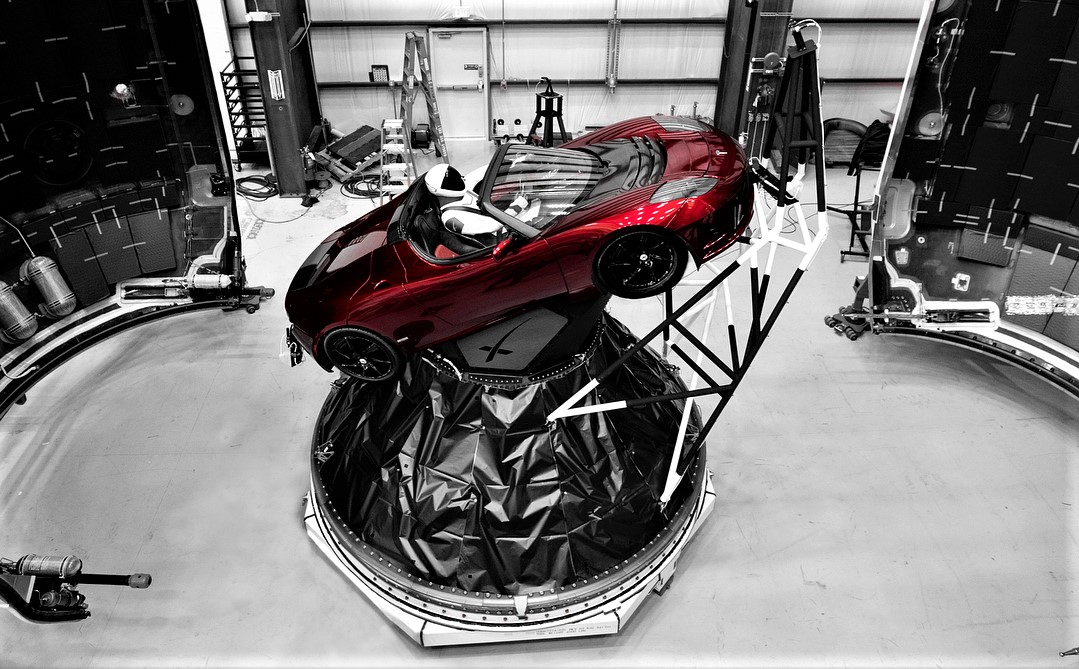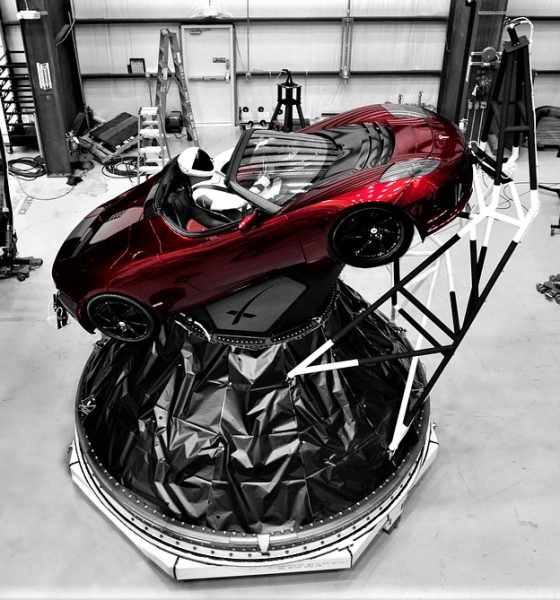

News
Tesla Roadster and ‘friends’ make history in newly-published log of 57k+ human objects in space
When the Tesla Roadster and its Starman occupant entered space aboard Falcon Heavy’s maiden voyage in 2018, it joined the ranks of one astronomer’s impressive database of human-made objects that have left Earth: The General Catalog of Artificial Space Objects (GCAT). It’s the most comprehensive collection of space object data available to the public, and its author recently published it in full for open-source use.
Jonathan McDowell, currently with the Harvard-Smithsonian Center for Astrophysics, created GCAT as an endeavor that began about 40 years go during his Apollo-inspired childhood.
“It was hard for me growing up in England to get details about space because the media there weren’t as interested in it as the U.S. media, so in a slightly obsessive way I started making a list of rocket launches… Now I have the best list,” McDowell told VICE in recently published comments. Lack of information in his younger days seems to have only been the beginning of the challenges the astronomer was willing to take on for his project. As detailed to VICE, McDowell also traveled to international space agency locations to obtain their old rocket lists and even learned Russian to translate that country’s space object data.
Although McDowell has been collecting his Catalog data for decades, the push to finally put all of his work online was inspired by more recent events. The risks of COVID-19 and “imminent death” threatened the database’s purpose. “There’s no point if it dies with me,” he told VICE. Publishing the GCAT had been in his plans, however, the pandemic pushed its priority to the top of McDowell’s personal bucket list.
- Data from GCAT (J. McDowell, planet4589.org/space/gcat)
- Data from GCAT (J. McDowell, planet4589.org/space/gcat)
- Data from GCAT (J. McDowell, planet4589.org/space/gcat)
- Data from GCAT (J. McDowell, planet4589.org/space/gcat)
So, what exactly might one use the GCAT for? McDowell had his own suggestions, including the determination of how many working satellites are currently in space. Since the data is easy to export into software that allows sorting of tab-delimited files, one could perhaps also look at the amount of debris produced over the years to get a general picture for how active spaceflight operations were in the past or how they may be progressing. Plenty of information about each object’s origin and owner is included for this kind of research.
One of the GCAT data sets tracks failed objects that would have otherwise made it to orbit. As an example, looking at the number of items from failed launch attempts in 1958 (52) gives a hint as to how intense the space race between the US and the Soviet Union was at the time. Data browsing could be used for general historical inquiry as well. For instance, Sputnik 1, launched by the Soviet Union on October 4, 1957, is object 00001; the Eagle lander still on the Moon from Apollo 11’s mission is object #04041; and the Tesla Roadster is object #43205.
Some of the data can inspire more historical awareness such as the listing of tools lost during on-orbit construction of the Soviets’ Mir Space Station in 1986. Of course, reminders of significant spaceflight misfortunes are also included like the Challenger Space Shuttle explosion in 1986 and SpaceX’s CRS-7 ISS resupply mission failure in 2015.
- Data from GCAT (J. McDowell, planet4589.org/space/gcat)
- Data from GCAT (J. McDowell, planet4589.org/space/gcat)
- Data from GCAT (J. McDowell, planet4589.org/space/gcat)
Since GCAT is inclusive of both functional items and notorious bits of space junk logged from decades of data digging, the Tesla Roadster and its 57,000+ “friends” are poised to help with some serious research now and in the far future.
“My audience is the historian 1,000 years from now,” McDowell explained. “I’m imagining that 1,000 years from now there will be more people living off Earth than on, and that they will look back to this moment in history as critically important.” For fans of Star Trek, this type of record keeping certainly seems to be relevant to future humans more often than not (away mission, anyone?). Perhaps that type of science fiction storyline will transpire into reality, just as so many of SpaceX’s achievements have done already.
Interestingly enough, McDowell is working on another project to track deep space objects beyond Earth’s orbit. Will space debris take center stage around Mars and beyond like it does around our own planet? Seeing the progress in one comprehensive database will certainly be an interesting way to show just how far humans have come since object #00001.

News
Nvidia CEO Jensen Huang explains difference between Tesla FSD and Alpamayo
“Tesla’s FSD stack is completely world-class,” the Nvidia CEO said.

NVIDIA CEO Jensen Huang has offered high praise for Tesla’s Full Self-Driving (FSD) system during a Q&A at CES 2026, calling it “world-class” and “state-of-the-art” in design, training, and performance.
More importantly, he also shared some insights about the key differences between FSD and Nvidia’s recently announced Alpamayo system.
Jensen Huang’s praise for Tesla FSD
Nvidia made headlines at CES following its announcement of Alpamayo, which uses artificial intelligence to accelerate the development of autonomous driving solutions. Due to its focus on AI, many started speculating that Alpamayo would be a direct rival to FSD. This was somewhat addressed by Elon Musk, who predicted that “they will find that it’s easy to get to 99% and then super hard to solve the long tail of the distribution.”
During his Q&A, Nvidia CEO Jensen Huang was asked about the difference between FSD and Alpamayo. His response was extensive:
“Tesla’s FSD stack is completely world-class. They’ve been working on it for quite some time. It’s world-class not only in the number of miles it’s accumulated, but in the way it’s designed, the way they do training, data collection, curation, synthetic data generation, and all of their simulation technologies.
“Of course, the latest generation is end-to-end Full Self-Driving—meaning it’s one large model trained end to end. And so… Elon’s AD system is, in every way, 100% state-of-the-art. I’m really quite impressed by the technology. I have it, and I drive it in our house, and it works incredibly well,” the Nvidia CEO said.
Nvidia’s platform approach vs Tesla’s integration
Huang also stated that Nvidia’s Alpamayo system was built around a fundamentally different philosophy from Tesla’s. Rather than developing self-driving cars itself, Nvidia supplies the full autonomous technology stack for other companies to use.
“Nvidia doesn’t build self-driving cars. We build the full stack so others can,” Huang said, explaining that Nvidia provides separate systems for training, simulation, and in-vehicle computing, all supported by shared software.
He added that customers can adopt as much or as little of the platform as they need, noting that Nvidia works across the industry, including with Tesla on training systems and companies like Waymo, XPeng, and Nuro on vehicle computing.
“So our system is really quite pervasive because we’re a technology platform provider. That’s the primary difference. There’s no question in our mind that, of the billion cars on the road today, in another 10 years’ time, hundreds of millions of them will have great autonomous capability. This is likely one of the largest, fastest-growing technology industries over the next decade.”
He also emphasized Nvidia’s open approach, saying the company open-sources its models and helps partners train their own systems. “We’re not a self-driving car company. We’re enabling the autonomous industry,” Huang said.
Elon Musk
Elon Musk confirms xAI’s purchase of five 380 MW natural gas turbines
The deal, which was confirmed by Musk on X, highlights xAI’s effort to aggressively scale its operations.

xAI, Elon Musk’s artificial intelligence startup, has purchased five additional 380 MW natural gas turbines from South Korea’s Doosan Enerbility to power its growing supercomputer clusters.
The deal, which was confirmed by Musk on X, highlights xAI’s effort to aggressively scale its operations.
xAI’s turbine deal details
News of xAI’s new turbines was shared on social media platform X, with user @SemiAnalysis_ stating that the turbines were produced by South Korea’s Doosan Enerbility. As noted in an Asian Business Daily report, Doosan Enerbility announced last October that it signed a contract to supply two 380 MW gas turbines for a major U.S. tech company. Doosan later noted in December that it secured an order for three more 380 MW gas turbines.
As per the X user, the gas turbines would power an additional 600,000+ GB200 NVL72 equivalent size cluster. This should make xAI’s facilities among the largest in the world. In a reply, Elon Musk confirmed that xAI did purchase the turbines. “True,” Musk wrote in a post on X.
xAI’s ambitions
Recent reports have indicated that xAI closed an upsized $20 billion Series E funding round, exceeding the initial $15 billion target to fuel rapid infrastructure scaling and AI product development. The funding, as per the AI startup, “will accelerate our world-leading infrastructure buildout, enable the rapid development and deployment of transformative AI products.”
The company also teased the rollout of its upcoming frontier AI model. “Looking ahead, Grok 5 is currently in training, and we are focused on launching innovative new consumer and enterprise products that harness the power of Grok, Colossus, and 𝕏 to transform how we live, work, and play,” xAI wrote in a post on its website.
Elon Musk
Elon Musk’s xAI closes upsized $20B Series E funding round
xAI announced the investment round in a post on its official website.

xAI has closed an upsized $20 billion Series E funding round, exceeding the initial $15 billion target to fuel rapid infrastructure scaling and AI product development.
xAI announced the investment round in a post on its official website.
A $20 billion Series E round
As noted by the artificial intelligence startup in its post, the Series E funding round attracted a diverse group of investors, including Valor Equity Partners, Stepstone Group, Fidelity Management & Research Company, Qatar Investment Authority, MGX, and Baron Capital Group, among others.
Strategic partners NVIDIA and Cisco Investments also continued support for building the world’s largest GPU clusters.
As xAI stated, “This financing will accelerate our world-leading infrastructure buildout, enable the rapid development and deployment of transformative AI products reaching billions of users, and fuel groundbreaking research advancing xAI’s core mission: Understanding the Universe.”
xAI’s core mission
Th Series E funding builds on xAI’s previous rounds, powering Grok advancements and massive compute expansions like the Memphis supercluster. The upsized demand reflects growing recognition of xAI’s potential in frontier AI.
xAI also highlighted several of its breakthroughs in 2025, from the buildout of Colossus I and II, which ended with over 1 million H100 GPU equivalents, and the rollout of the Grok 4 Series, Grok Voice, and Grok Imagine, among others. The company also confirmed that work is already underway to train the flagship large language model’s next iteration, Grok 5.
“Looking ahead, Grok 5 is currently in training, and we are focused on launching innovative new consumer and enterprise products that harness the power of Grok, Colossus, and 𝕏 to transform how we live, work, and play,” xAI wrote.













